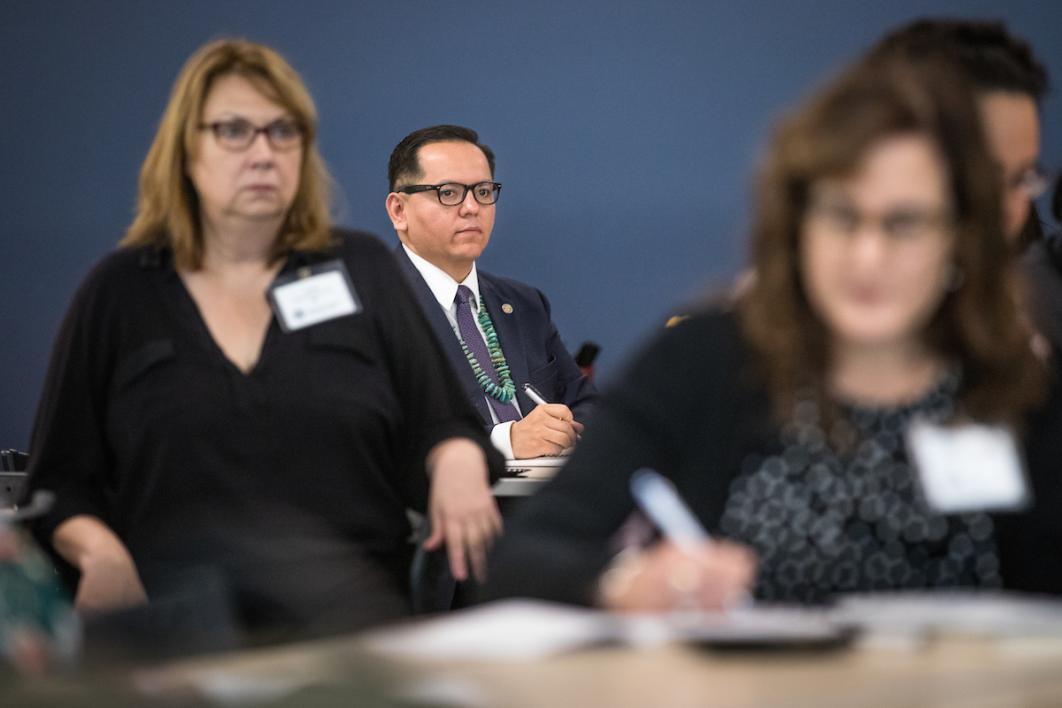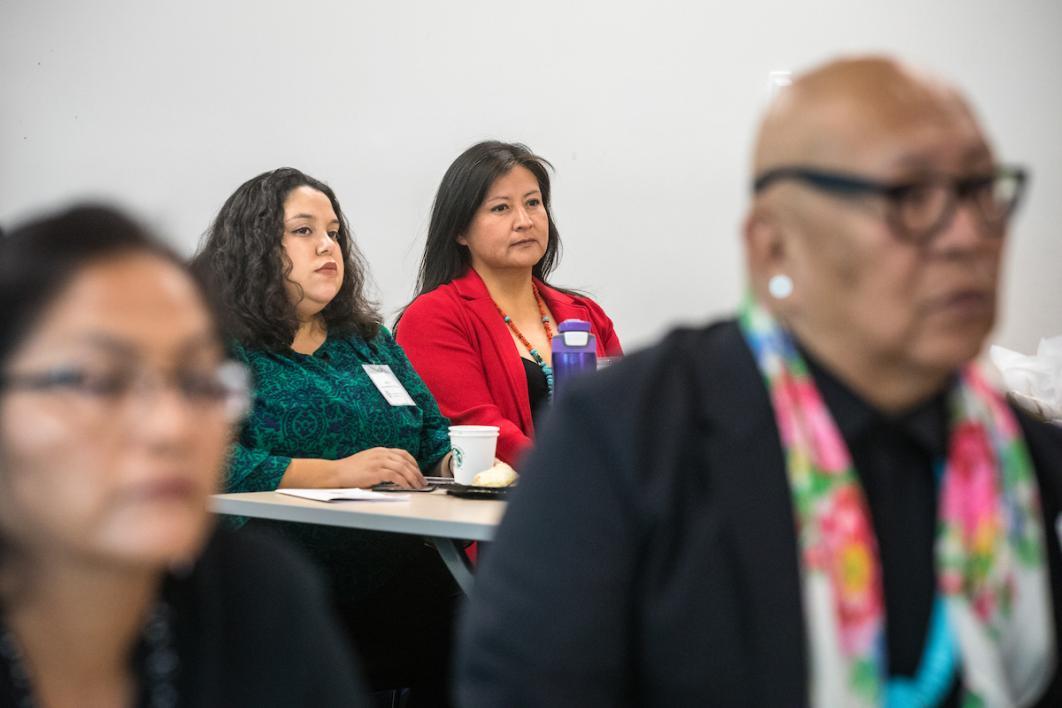ASU scholars, students embed in indigenous communities with research in Indian Country

NCAA college basketball rarely makes it to the far reaches of the Navajo Nation. But this weekend, the Arizona State University women’s basketball team will take on national powerhouse Baylor University in Fort Defiance, Arizona.
Organized in conjunction with ASU’s Office of American Indian Initiatives, the “Showdown on the Rez” will take place on Veterans Day and serve as a celebration of Native American Heritage Month, as well as provide a platform to recognize and honor Native Americans who served in the armed forces.
Watch: ESPN2 will broadcast the Showdown on the Rez on Sunday
But athletes aren’t the only members of the Sun Devil family making an impact on indigenous communities around Arizona. The university also boasts another VIP team — faculty, staff, researchers and students who contribute to the well-being and advancement of the 22 tribes in Arizona.
Health care, language preservation, molecular science, sustainability, research methodologies, higher education experiences: ASU has a wide breadth of research and interaction taking place in Indian Country. And this is evident throughout the year, not just in November.
“One of the hallmarks at ASU for our work with tribal communities and Native students is about building capacity and creating futures of their own making,” said Bryan McKinley Jones Brayboy, President’s Professor, director of the Center for Indian Education and ASU’s special adviser to the president on American Indian affairs. “Our goal is to interface with all 22 tribes and nations and every Native person in Arizona if we can.”
They’re making a good dent in the Navajo Nation. Lamont Yazzie is currently a fourth-year doctoral student in the justice studies program in the School of Social Transformation, where his dissertation work on research methodologies is helping advance Diné learners.
Specifically, his research compares the space between Western society in America and indigenous communities, the structural oppression that exists and how their people have responded to education hurdles in the past.
“It’s paying homage to the knowledge systems of our ancestors because everything we have needed has always been there,” Yazzie said. “Looking at education through a Navajo lens, we can legitimize our thought process, legitimize our perspective and legitimize our way of life.”
Colin Ben, a citizen of the Navajo Nation and a postdoctoral research scholar in the School of Social Transformation, is also researching Navajo education. His paper, “Navajo Student Decision Making,” was presented at the “Doing Research in Indigenous Communities" conference, a partnership between ASU’s Office of Knowledge Enterprise Development and the Office of American Indian Initiatives that was held Nov. 1–2 at ASU SkySong.
His research examines decision-making factors influencing Diné students’ pursuit of doctoral education and their experiences of persisting in graduate school despite difficult and discouraging experiences.
Ben discovered that indigenous students face more hurdles than most, including cultural transitions, isolation, financing programs, obligations to the tribal community, taking care of elderly parents, driving long distances to school and maintaining a full-time job.
“There’s a toll that it takes on them, not only financially but physically and mentally. It was wearing them out,” Ben said. “But what pushed them through was the fact that they wanted these advanced skill sets to enhance their career opportunities and trajectory. Also, they had a strong desire to give back to their community.”
Ben said he has shared his findings with his tribal elders, as well as with ASU administrators to address policy issues to better serve Native students.
That’s exactly what Deborah Chadwick is doing in her work as project director of the Center for Indian Education. In 2014, she developed a first-of-its-kind program that trains future teachers on their home reservation with a focus on tribal history and keeping alive the Akimel O’otham language. The first master's cohort graduated in spring 2018.
This year Chadwick is thinking beyond the borders of the Akimel O’otham reservation and has been an integral part of the newly offered online master’s degree program in indigenous education being launched next spring. The 30-credit program will be taught by mostly indigenous faculty and is specifically geared toward Native Americans who live in remote sites and on reservations.
“It’s not just for people in Arizona but nationally and internationally,” Chadwick said. “We’ve had inquiries from around the world.”
Tennille Marley, a citizen of the White Mountain Apache Tribe and an assistant professor in the American Indian Studies program, recently finished research on two papers dealing with diabetes in tribal communities and data sovereignty in the research process.
Her paper “History: A Determinant of American Indian Health” examined how history has impacted diabetes. She said colonization, especially by the U.S. government, heavily influenced dietary practices of Native Americans by placing them on reservations and introducing rations, which many were forced to take for survival.
“They replaced our traditional diets. For example, fry bread and tortillas, which are not traditional dishes, are now a staple,” Marley said. “I’m hoping the paper will encourage Native American communities to go back to our traditional dietary practices and to help health care providers and research better understand diabetes in Native American communities.”
She has a willing ear in David R. Wilson, a citizen of the Navajo Nation and an ASU doctoral graduate. Wilson is the first director of the Tribal Health Research Office at the National Institutes of Health in Bethesda, Maryland, which was established in 2015.
Wilson also attended the conference at ASU SkySong, which was a gathering of approximately 175 Native American faculty and researchers at ASU and visitors. Wilson was a keynote speaker, but he was also there to communicate the work that happens across the NIH with tribal nations.
“The overall goal of the NIH’s engagement in this event is to not only introduce the Tribal Health Research Office but also to convey the importance of the NIH’s commitment to health in tribal communities through research,” Wilson said. “An important part of that is to increase opportunities for professional development to the Native American student base that exists here. Also, to collaborate with tribes that are interested in research. The best way to accomplish this is to increase communications between the university, the NIH and tribal nations. A successful collaboration will lead to a more diverse biomedical research community that also understands the cultural competencies that are important and respectful to ethical research in the tribal communities.”
While most of the research being conducted by indigenous scholars at ASU is being carried out in the field and in the classroom, some of it is being done in labs. Gary F. MooreMoore was the recipient of the National Science Foundation’s CAREER grant, a prestigious grant to support emerging academic scholars. This year, he was one of three doctoral advisers recognized nationally as an exceptional mentor by the ARCS Foundation., an assistant professor in the School of Molecular Sciences and a researcher in the Biodesign Center for Applied Structural Discovery, studies what plants can teach us about solar energy storage, which currently is too expensive to use on a mass scale.
“My research group is investigating the molecular science required to produce fuels and other valuable chemicals from sunlight, water and air, thereby replacing fossil inputs and creating renewable processes,” said Moore, a chemist from the Powhatan Pamunkey tribe in Virginia. He is researching methods to harness sustainable energy using approaches inspired by nature’s process of photosynthesis.
He said that although his lab is not currently working with an Arizona tribe, he believes this type of approach has great appeal to nations looking to harness energy in a decentralized fashion and with minimal environmental disruption.
“Each house could become its own power plant,” Moore said. “It’s an approach that could potentially fit well with tribal communities if those communities are willing and receptive to adopting such technologies.”
Read: New magazine, ASU initiatives help Native students reach a ‘Turning Point’
Top photo: ASU Associate Professor Angela Gonzales speaks during a panel discussion on "What is indigenous research? What does research in indigenous communities look like?" The panel was part of the two-day conference on "Doing Research in Indigenous Communities" at ASU SkySong on Nov. 1–2. The morning panel discussion drew around 60 people including several ASU students. Photo by Charlie Leight/ASU Now
More Health and medicine

Dynamic data duo advances health research
The latest health research promises futuristic treatments, from cancer vaccines to bioengineered organs for transplants to medical nanobots. While these technologies may one day be…

New study reveals high levels of toxins in seized cannabis from Arizona and California
A recent study conducted by researchers from Arizona State University has uncovered alarming levels of Fusarium mycotoxins in illicit cannabis samples seized in Arizona and California.The study found…

PhD student builds bridges with construction industry to prevent heat-related illnesses
It is no secret that Arizona State University has innovative researchers working to help solve everyday problems.According to a new preliminary report issued by Maricopa County, there were more…




